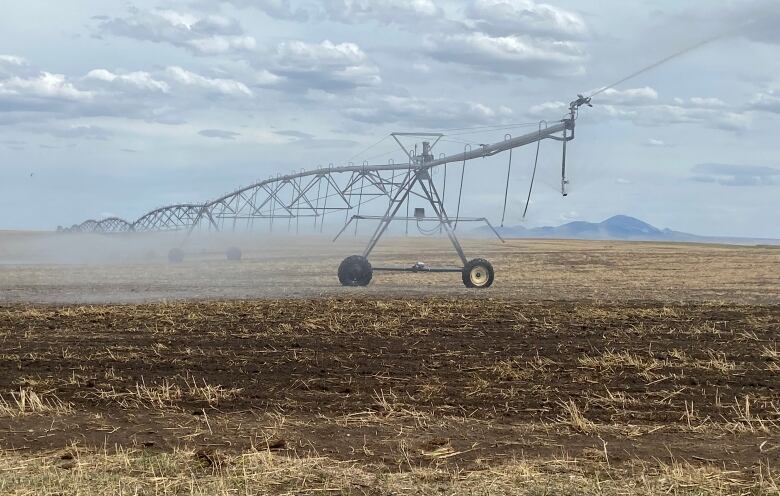Alberta to launch 'unprecedented' water-sharing negotiations Thursday amid drought fears
Talks with major water licence holders to begin for the first time since 2001

Alberta will kick off negotiations with major water licence holders to strike water-sharing agreements forthe Red Deer River, Bow River and Old Man River basins Thursday as concern over looming water shortages grows.
Significantly reduced mountain snowpackand below-average precipitation over the past number of months has led to extremely low reservoir levels and record-low river levels. All of the province will be affected by that, but southern Alberta's agricultural sector is expected to face particularly significant challenges.
As such, for the first time since 2001, the provincial government said it has authorized its drought command team to begin negotiations with themajorwaterlicence holders.The "scope and scale of the collaborative work underway and being proposed" is "unprecedented" in Alberta's history, the province said.
The use of water is restricted in Alberta through the issuing of "water licences" by the provincial government. One hundred per cent of southern Alberta's water is already allocated.
If one wants to purchase a licence, they must purchase one from an existing licence holder. This system referred to as "first in time, first in right" has been in placesince 1894. It means, in essence, that the biggest water licence holders must voluntarily share more water with municipalities and industry.

There is no law in place that would allow the province to force water licence holders to share their water. There are25,000waterlicence holders in Alberta, according to the province, which make up9.5 billion cubic metres ofwater.
Starting Feb. 1, AlbertaMinister of Environment and Protected AreasRebecca Schulz said negotiations would begin with major water licence holders to secure "significant and timely reductions inwateruse."
"This effort will be the largestwater-sharingnegotiation to have ever occurred in Alberta's history. I want to thank licence holders for coming to the table your generosity, ingenuity and participation in this effort reflects the very best of our province," Schulz said.
Irrigation the supply ofwater to the agricultural sector via a network of canalsis a significant user of the province's water, and negotiations with irrigation districtswill be a key plank as a part of these upcoming negotiations. Alberta has the largest irrigated area in Canada, most of which is located within the province's 11 irrigation districts in southern Alberta along the South Saskatchewan River Basin.
Irrigation made up a little more than 73 per cent of water allocation in the Bow River sub-basin and a little more than 83 per cent of water in the Old Man sub-basin as of 2020, according to figures from Alberta Environment and Parks.

Shannon Frank, executive director of theOldman Watershed Council, said water sharing agreements will be critical in the months ahead so as to ensure that no one loses access to water.
"The major water users, the irrigation districts in particular, have committed to making sure that there's access, especially for human health and livestock first," Frank said. "Crops have to take the third seat if there's not enough."
Frank said she didn't want to sugarcoat the situation ahead, as it's likely to be a challenging year. There will potentially be lower crop yields, which will impact the economy.
WATCH | Why farmers are worried about the coming growing season:
More ranchers are likely to have to sell off their cattle because their grass isn't growing and water isn't available, she added. Municipalities may also have such low flows that they may not be able to pump water into their treatment plants.
"We might only be at the beginning of this drought, we don't really know," Frank said. "Everyone's just kind of waiting to see what the snowpack does, what the spring rain does."
Irrigation districts ready for adjustment: vice-chair
Richard Phillips, general manager of the Bow River Irrigation District and vice-chair of the Alberta Irrigation Districts Association, said he didn't expect it would be too difficult to agree on basic principles.
"We are absolutely willing and prepared to share, and have reconfirmed that recently," Phillips said.
While therewill likely be less production on irrigated land if drought persists, what Phillips said he expects will happen is that each irrigation district will set an allocation for their farmers in terms of how much water they're allowed to apply. From there, each individual farmer will decide where best to apply that water.
He added that the situation is not exactly the same across the province in terms of reservoir storage, with variability across the region.
The Alberta Energy Regulatorlate last yearwarned licence holders thatlow flows and low water levels were likely to persist into the 2024 calendar year.The Alberta Rivers app shows 51 current water shortage advisories in Alberta.
In an interview with CBC News earlier this month, Schulz signalled that a review into the province's water licence system was likely. She did not rule out the possibility of the province declaring a state of emergency, depending on how the next number of months play out.
The water-sharingagreementsare expected to be completed before March 31.













_(720p).jpg)


 OFFICIAL HD MUSIC VIDEO.jpg)
.jpg)



























































































